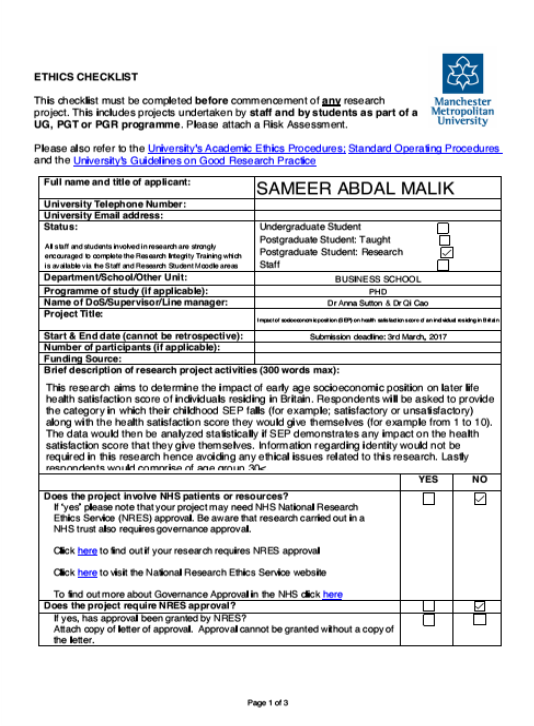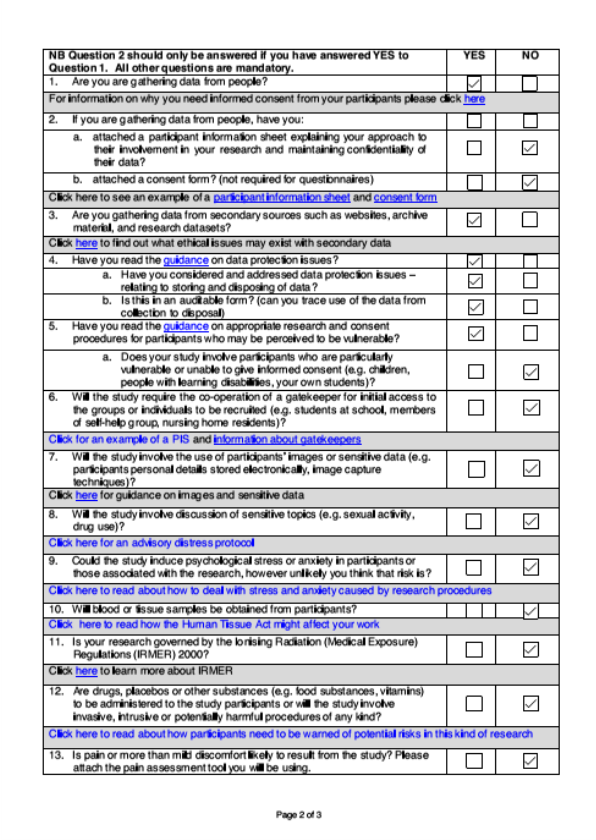Relationship between Health and Socio-Economic Condition
Health and socio-economic position (SEP) decide ‘quality of life’ that a person would have over lifespan. In this article, socio-economic position (SEP) is referred to those economic factors which are derived socially. Also, the factors which decide the position of an individual or group within a multiple stratified construction of a society (Galobardes et. al., 2007). Past researches debated on the fact that SEP and health often possess a causal effect on one another. Recent studies further revealed that impact on a person starts from a very early age and early age circumstances then decide what health and SEP the person would have when they grow up to be adults. Improvement in one has been reported to cause enhancement for another. Though various studies have explored the relationship between two variables, results have various contradictions regarding their causality and impact. These irregular findings generally arose due to different research methods and variant sampling techniques. Research problem in author’s case is to understand if early age socio-economic position (SEP) impacts health of individuals when they reach adulthood. This could be analyzed by one of the methods in which respondents would be asked to give a health-satisfaction score to themselves in a questionnaire. Satisfaction scores is a method by which a respondents are asked to analyze themselves and give them a score according to their experience or understanding.
Respondents will be asked to provide the category in which their childhood SEP falls (for example; satisfactory or unsatisfactory) along with the health satisfaction score they would give themselves (for example from 1 to 10). The data would then be analyzed statistically if SEP demonstrates any impact on the health satisfaction score that they give themselves. Information regarding identity would not be required in this research hence avoiding any ethical issues related to this research. Lastly respondents would comprise of age group 30<
The literature presented in this study comprises of the critical evaluation of various researches that took place in last two decades. Literatures have been reviewed to find the gap that exists currently in this portfolio.
After analyzing various studies, author has come up with the understanding that the relative contribution of childhood socio-economic circumstances on health is not fully understood to this date (Ploubidis et al., 2014). Various studies have been conducted from the early 2000s that explore the relationship between the two observed variables (Shanahan, 2000; Poulton et al., 2002; Shlomo & Kuh, 2002; Kuh et al., 2003; Hayward & Gorman, 2004 and Lynch & Smith, 2005). Though all of the above mentioned studies focused on early life SEP impacting later life health and social circumstances, almost all of them had varied and contradictory findings. Some literatures stressed on the no-causality theory amongst the variables (Foverskov & Holm, 2016), suggesting that there is no impact of childhood circumstances on later life and the differences arise due to dynamics and influences that takes place before the respondents reach elder phase of life. Adams et al., (2003) presented a similar report in which no relationship between early life circumstances and older age mortality was found amongst the targeted audience. In order to understand no-causality approach on a better note, author investigated studies that focused on gender specific observation for more depth into this subject. Elgar et al (2017) presented the findings in which no association between early life social circumstances and later life SEP was observed for males. Also, it was observed that females showed no proof of social-causation hypothesis with regard to their health and childhood SEP in a research conducted by Foverskov & Holm in 2016.
In contrast to the no-causality findings, a number of researches observed an impact of early life SEP on health and social circumstances. Shlomo & Kuh (2002) mentioned that people from more financially strong family backgrounds possess better chances of achieving a high SEP in adult life as compared to the ones from rather weaker financial family background. This phenomenon is mentioned in the research by Uhlenberg & Mueller in 2003 that family conditions in childhood and later life are one of the most important factors affecting a person’s life course and SEP in adulthood. Further elaboration in the research of Shlomo & Kuh, 2002 brings out the fact that health of an adult individual gets affected due to later-life SEP that has been influenced by early circumstances of childhood. This later life SEP may in turn affect disease risk by prompting health related behavior, causing raised stress levels or by the access to healthcare (Shlomo & Kuh, 2002). Additional research by author led to gender specific observations in this context. Observed females in a research population by Elgar et al (2017) showed poor health in later life due to income inequality in infancy. Hayward & Gorman (2004) stressed on the mortality of elder men to be associated with early life SEP.
The evidence analyzed from the above mentioned literatures suggest that there are contradictions amongst different studies and there is a need to fill this gap in order to produce much reliable findings. Author investigated that some of these literatures focused on biological factors (Sandstedt et al., 2016; Ploubidis et al., 2014) whereas some merely observed social sciences (Foverskov & Holm, 2016) as a means to observe impact of early life SEP. Also the observations made are either on a small sample group or for shorter period of duration. Author of this study aims to conduct an observation on citizens currently residing in Manchester to investigate the impact of independent variable i.e. SEP, which brings us to the research aim and objectives of this exploration.
RESEARCH AIM AND OBJECTIVES
To evaluate the impact of early age social economic position (SEP) affecting health satisfaction score (HSS) of British citizens at later age.
In order to achieve the aim of this study, the following specific objectives were formed:
- To evaluate results from respondents older than 30 years of age for better accuracy
- To include ample amount of sample population from both types of SEP categories for authentic investigation
- To include responses from both genders in this exploration in order to counter gender biased results
The method chosen for this research is to collect primary data by distribution of questionnaires. The research population comprised of 50 people who were asked to fill in the quantitative research questionnaire. It is to be noted that all the respondents were residents of Manchester city. Out of those 50 respondents, 30 were fit to be added into the sample population of this project. Excluding 20 questionnaires from the research population is done in order to be in line with the research objectives. It is necessary for authenticity and accuracy of this study that all the biases are removed hence a detailed explanation of choosing the appropriate sampling strategy is as followed:
As this study focuses on the impact of childhood SEP on adolescent health, selected participants were either older or equal to 30 years of age. Author believes that including results of respondents less than 30 years of age would have limited the data in terms of the health related problems that they might would undergo after turning 30 years old (Belsky et. al., 2015). Secondly, proper consideration is made in order to include responses falling into both categories of SEP. To analyze an impact on HSS, it seemed necessary to include almost equal amount of respondents that belonged to either a satisfactory or unsatisfactory childhood SEP. Lastly, some of the responses were omitted from this research to maintain a balance of questionnaires including both males and females. As mentioned earlier, the intent is to remove any gender bias that can impact the authenticity of the results. This became evident by reviewing various literatures which highlighted the fact that males and females might exhibit different trends regarding their health (or HSS) due to biological and social reasons. Moving on, the overall data collected from respondents in the questionnaires included their age, gender, resident status in UK, childhood SEP and health satisfaction score that they gave themselves.
In order to code the data into SPSS, responses were given a numerical value. There were a total of 5 questions that were asked in the questionnaire. First question inquired gender of the respondent. In SPSS, male respondents were assigned a numerical value of ‘1’ whereas females were denoted by number ‘2’. Response for age was limited to three categories i.e. if the respondent was below 30 years of age, above 30 years of age or prefer not to say. These answers were coded numerically as 1, 2 and 3 respectively. The responses from age group less than 30 were pre-screened and excluded, hence the only coded age response is 2 for all 30 respondents in SPSS. Fourth question comprised of independent variable of this study, responses confirming ‘satisfactory SEP’ are coded as 1 and ‘unsatisfactory SEP’ as 2 in SPSS. Health satisfaction score, which is a dependent continuous variable has been coded between an open range of 1 to 10. 1 depicts extremely poor HSS and 10 as extremely good in the questionnaire and it is not categorized into any scale to keep the data continuous.
The proposed method to find out the impact of SEP on health satisfaction is T-test in this project. The reason behind choosing T-test as a statistical technique is due to the fact that; one categorical independent variable (SEP) is compared against a continuous dependent variable (Health Satisfaction Score). SEP has 2 categorical outcomes as examined in the questionnaire namely; satisfactory or un-satisfactory. Satisfactory SEP means that the respondent had his/her social position strong at the time of childhood. This involves financial conditions of the parents, schooling and access to quality healthcare. Subsequently, unsatisfactory SEP depicts rather weak financial background of the respondent, weak financial status of parents during childhood period of respondent and limited access to schooling and healthcare options.
Health Satisfaction Score (HSS) in this project is considered to be a continuous variable. Respondents were expected to provide any figure between 1 -10. In order to fulfill the criteria of receiving continuous data from respondents, they were given a lower and upper limit. Their answers could be fall between and any value between the 2 limits including decimals. However, it is to be noted that ‘all’ of the respondents chose to provide the score as a whole number i.e. 1,2,3,4 etc.
All the acquired data is entered directly into SPSS for conducting Independent T-test. In order to ensure the authenticity of independent sample test, a check for variance is also conducted which shows that the data has normal variance and thus can be used to conduct the test.
ACQUIRED DATA
After conducting Independent sample test, results revealed group statistics of 18 males and 12 females from a total of 30 respondents. Although the distribution of genders is not equal but it is deemed significant to highlight evidences from both sides. From the responses received it was revealed that 14 people chose their childhood SEP position to be satisfactory and 16 people answered an unsatisfactory socio-economic position. SPSS calculated the mean responses which specify 7.28% and 5.00% for satisfactory and unsatisfactory SEP respectively. Further in-depth exploration revealed that among 18 males, only 7 reported childhood SEP to be satisfactory while others experienced vice versa. Among the 12 females, 7 females were satisfied with their SEP position and 5 were unsatisfied. Table representing the findings is presented below as ‘Table 1’:
|
Group Statistics |
||||
|
Health Satisfaction Score |
SEP Position |
N |
Mean |
Std. Deviation |
|
Satisfactory |
14 |
7.28 |
1.857 |
|
|
Un-satisfactory |
16 |
5.00 |
2.22 |
|
TABLE 1
Findings revealed from the Independent sample test discovers that the significance in Levene’s Test is greater than .05. Put scientifically, it means that the variability in the two conditions is not significantly different. As the value is greater than .05, results from the first row are considered. 2-tailed significance of this test came out to be 0.005. As this value is less than .05 it can be concluded that there exists a statistically significant difference between the two conditions. It can also be concluded that the difference between condition Means are not likely due to change and are probably due to the alteration in SEP position. Table representing Independent sample test is shown below as Table 2:
|
Independent Sample Test |
||||||
|
F |
Sig. |
T |
df |
Sig. (2-tailed) |
||
|
Health Satisfaction Score |
Equal variances assumed |
0.415 |
0.524 |
3.031 |
28 |
0.005 |
|
Equal variances not assumed |
3.069 |
27.955 |
0.005 |
|||
TABLE 2
After discovering the findings of this test, author interprets them formally as followed:
“An independent-samples t-test was conducted to compare the health-satisfaction scores for people with either satisfied or un-satisfied childhood SEP. There was significant difference in scores for satisfied and unsatisfied ones, t (28 df) = 3.03, p = .005, two-tailed)”.
This exploration was carried out to analyze if there is a significant impact on HSS of individuals who had different SEP in their childhood. Findings verified this difference which brings us to the conclusion of this research. Majority of the individuals who had a satisfactory childhood social conditions had a better schooling and accessibility to enhanced health measures as explained in the introduction section. As they reached the age of >30, they experienced less health related problems and gave themselves a better HSS. There are a various number of reasons that support the mentioned argument. Biological reasoning indicates that having a healthier childhood (resulting from better SEP) helps in building stronger immune system in body even when aging symptoms begin to appear. Social and psychological reasoning indicates that as a child is nourished properly at childhood, he forms cognitive behaviors that help in maintaining healthier habits and increased awareness related to health throughout the life span.
On the other hand majority of the individuals who had unsatisfied childhood SEP gave themselves a lower health satisfaction score. This also indicates that their access to healthcare was limited in childhood and so they adapted to a lifestyle in which less care was given to treatment of health related problems. This can lead to various problems that might start impacting an individual health when aging symptoms start to appear on an individual. Biologically, it can be assumed from the evidence in literature that their immune system is weaker as compared to other group of people and more exposed to disease risk after adolescence.
This research is not without limitations. There are many factors that could have been considered to obtain more authentic results for the research problem. One of the major limitation is the sample population that comprises of 30 respondents only, having a population in hundreds/thousands would have yielded a more reliable result for this exploration. As explained in literature, males and females exhibit different impacts of SEP in their adulthood. A future research which focuses separately on the impact on males and females can give a deeper insight to this portfolio. It could be analyzed if females show more related health problems than males after they are >30 or vice versa. Furthermore this research focused on health satisfaction scores of individuals as a dependent variable. Author believes that satisfaction scores might not be the most suitable option to compare with SEP in order to determine the impact. This score might be biased or given upon the current conditions of individuals rather than portraying a span of time after their adolescence. Future researches including a longitudinal data of males and females in UK may actually provide a reliable data with depending on health-affecting diseases rather than health satisfaction scores.
References
Hayward, M. D. & Gorman, B. K., 2004. The Long Arm of Childhood: The Influence of Early-Life Social Conditions on Men’s Mortality. Demography. Vol. 41(1). Pp. 87-107. http://www.jstor.org.ezproxy.mmu.ac.uk/stable/1515214?seq=1#page_scan_tab_contents
Jenkins, S. P., 2011. The British Household Panel Survey and its Income Data. Institute for Social & Economic Research. No. 2010(33). https://www.iser.essex.ac.uk/files/iser_working_papers/2010-33.pdf
Kuh, D., Shlomo, B. Y., Lynch, J., Hallqvist, J. & Power, C., (2003). Life course epidemiology. Journal of Epidemiology and Community Health. Vol. 57 (10), pp. 778-783.
http://go.galegroup.com.ezproxy.mmu.ac.uk/ps/i.do?p=AONE&u=mmucal5&id=GALE|A110812993&v=2.1&it=r&sid=summon&authCount=1
Ploubidis, G. B., Benova, L., Grundy, E., Laydon, D. & DeStavola, B., 2014. Lifelong Socio Economic Position and biomarkers of later life health: Testing the contribution of competing hypotheses. Social Science & Medicine. Vol. 119. pp. 258-265. http://www.sciencedirect.com/science/article/pii/S0277953614001221
Poulton, R., Caspi, A., Milne, B. J., Thomson, W. M., Taylor, A., Sears, M. R. & Moffitt, T. E., 2002. Association between children’s experience of socioeconomic disadvantage and adult health: a life-course study. Lancet. Vol. 360(9346). pp. 1640-1645. https://www.ncbi.nlm.nih.gov/pmc/articles/PMC3752775/
Sandstedt, P., Johansson, S., Ytterberg, C., Ingre, C, Holmqvist, L. W. & Kierkegaard, M., (2016). Predictors of health-related quality of life in people with amyotrophic lateral sclerosis. Journal of the Neurological Sciences. Vol. 370, pp 269-273
http://www.sciencedirect.com/science/article/pii/S0022510X16305998
Shanahan, M. J., 2000. Pathways to Adulthood in Changing Societies: Variability and Mechanisms in Life Course Perspective. Annual Review of Sociology. Vol. 26(2000). pp. 667-692.
http://www.jstor.org.ezproxy.mmu.ac.uk/stable/223461?pq-origsite=360link&seq=1#page_scan_tab_contents
Shlomo, Y. B., 2002. A life course approach to chronic disease epidemiology: conceptual models, empirical challenges and interdisciplinary perspectives. International Epidemiological Association 2002. Vol. 31. Pp. 285-293. http://ije.oxfordjournals.org/content/31/2/285.full.pdf+html
ETHICS CHECKLIST


